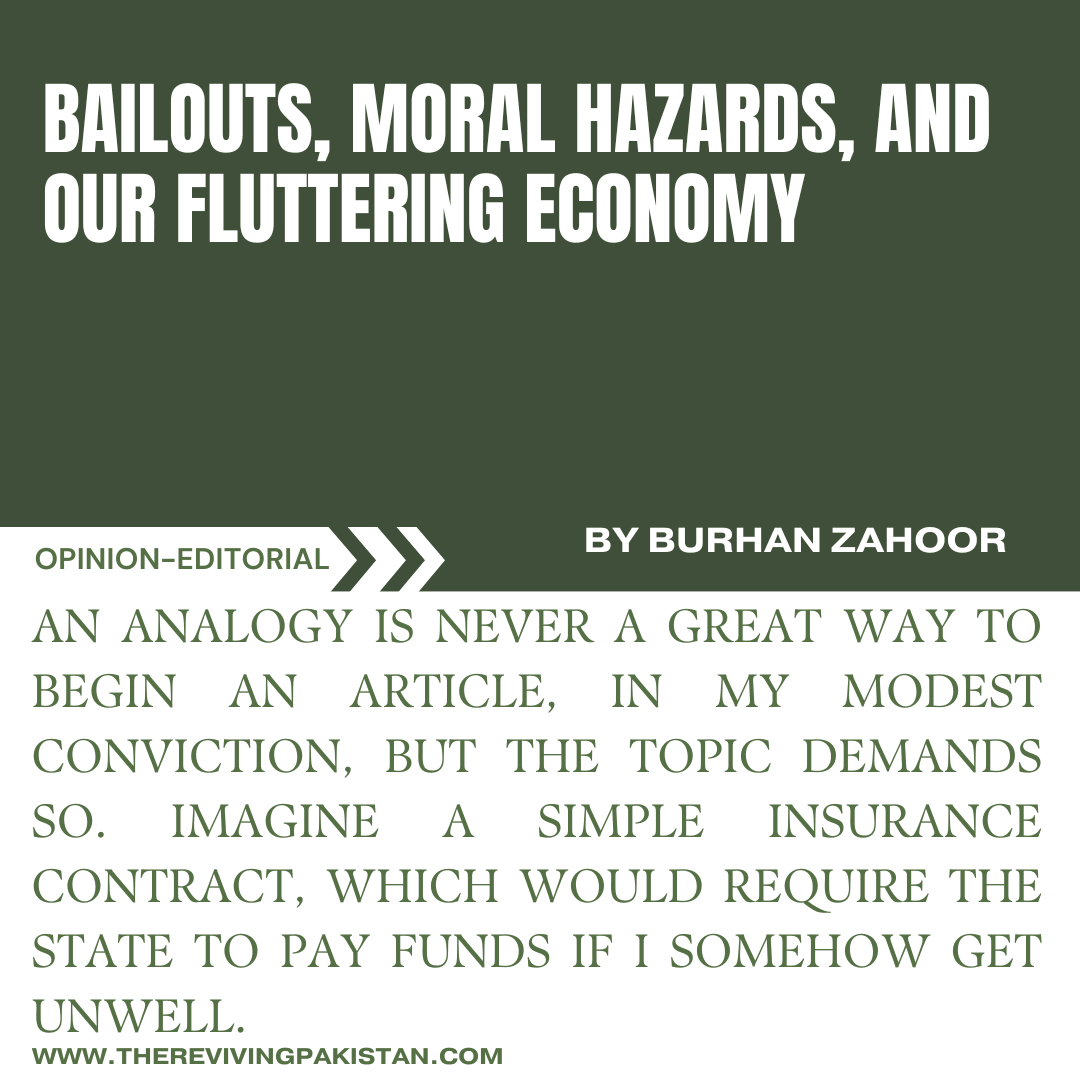About the Author(s)
Burhan Zahoor is a second-year student at the Lahore University of Management Sciences (LUMS), currently pursuing his bachelor’s in economics.
An analogy is never a great way to begin an article, in my modest conviction, but the topic demands so. Imagine a simple insurance contract, which would require the state to pay funds if I somehow get unwell. The incentive to take care of myself is not the same as before, because the “polity” got me covered. This is a moral hazard. Extending the concept into the realms of economics would be to replace, let’s say, me with a state and the state with a major financial entity, IMF, for instance. The state is at the brisk of default, and IMF issues a bailout to stabilize the economy and support the tattered domestic financial safety net. The state has little to lose now, so it would opt for less recommended policies. This works within the country’s financial safety net as well. Again, a little word game: replace the state with banks that are “too big to fail” and replace the IMF with the government. The circle continues.
So, do bailout deals actually present a moral hazard?
Statistics say otherwise. The “IMF’s large-scale crisis loans of the 1990s” were issued with meager interest rates, but either they have been paid or are in the process. This suggests that bailout packages are not inherently evil; as the statistics show, they have shoved countries up.
What is the problem, then? Where the international bailout may not directly contribute to all moral hazard shenanigans, moral hazards are created anyway. The problem lies within the close bond between international lending and domestic policies. See, the financial entity is going to support; problems would arise if the formulated policies are bad, i.e., implicit government guarantee.
Pakistan has a glorious history of IMF lending, with 23 bailout packages under its belt and an outstanding debt of more than 130 billion dollars, making Pakistan one of the biggest borrowers. The blame must now go from international entities and bailouts to the grim domestic policies and fragile economic structure.
A country totally reliant on its agricultural sector, with a half-backed, more-burnt industrial sector, had to deal with an influx of refugees. Apart from agriculture, we had Jute from East Pakistan and Foreign Exchange Earnings (FEE), which are the monetary funds gained by selling services and goods in the global market. An economic model, if dared to call such, having such a shaky foundation was bound to fall. And when it did in 1950, we joined IMF.
The year is 1958, and the moth-ridden economy is crumbling under the weight of, well, not the weight, technically, as government accounts are hollow, but regardless, under the weight of dwindling foreign exchange reserves and current account deficit. The first bailout package we received was around 25,000 dollars. Pakistan’s incapability to respond to any challenge was due to structural fragility, total reliance on agriculture, and inadequate industrial infrastructure.
The era between 1965-1978 is characterized by wars and the separation of an economic unit. Funds poured in and went straight into army barracks. GDP took a toll to 4.84 percent in the 1970s. Bhutto’s nationalization, where the downtrodden merry, lessened the competition between the private sector. Bhutto was famous for his illiberal policies, which got him a fair amount of criticism and, ironically, kept Gen Zia in power due to the later boom.
Zia’s regime (1977-1988) was no less of a nightmare. Unnecessarily stepping into the Afghan war, where some funds were poured in, created other problems that should not be discussed here. Also, aligning ideologies and policies with the Gulf poured some more funds. The remittances from the Gulf caused the middle class to emerge as a formidable force that later shaped our economic horizon.
After Zia’s death came, as S. Akbar Zaidi calls it, the “Era of structural adjustment” marked by four general elections and governments not completing their tenures. Fast forward, we got Musharraf and the handing out of bases. Again, funds poured in.
The pattern must have become evident at this point in time. Support a proxy war, get funds, and give a brief boom to the economy at the expense of structural default.
Now, what do bailout packages have to do with all this? Sheer’s incompetency and inability to reform an economic model, if dared to call such a thing as mentioned above, also does not let the “phoenix rise.” There is a list of TV anchors boldly claiming that bailout packages are what keep Pakistan’s economy in a beleaguered state, but they have always failed to mention how this flittering economy would function otherwise.

